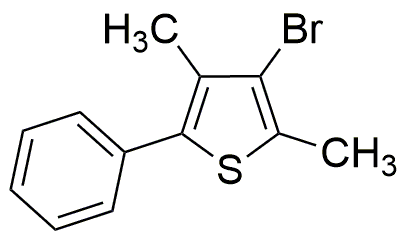3-Bromo-2,4-dimethyl-5-phenylthiophene is widely utilized in research focused on:
- Organic Electronics: This compound serves as a key building block in the synthesis of organic semiconductors, which are essential for developing flexible and lightweight electronic devices.
- Pharmaceutical Development: It is used in the design of novel pharmaceutical agents, particularly those targeting specific biological pathways, enhancing drug efficacy and specificity.
- Material Science: The compound plays a role in creating advanced materials with unique properties, such as improved conductivity and stability, beneficial for various industrial applications.
- Photovoltaics: It contributes to the development of organic solar cells, offering a more sustainable and cost-effective alternative to traditional silicon-based solar technology.
- Research in Organic Synthesis: This chemical is valuable in academic and industrial research for developing new synthetic methodologies, allowing chemists to explore innovative reactions and compounds.
General Information
Properties
Safety and Regulations
Applications
3-Bromo-2,4-dimethyl-5-phenylthiophene is widely utilized in research focused on:
- Organic Electronics: This compound serves as a key building block in the synthesis of organic semiconductors, which are essential for developing flexible and lightweight electronic devices.
- Pharmaceutical Development: It is used in the design of novel pharmaceutical agents, particularly those targeting specific biological pathways, enhancing drug efficacy and specificity.
- Material Science: The compound plays a role in creating advanced materials with unique properties, such as improved conductivity and stability, beneficial for various industrial applications.
- Photovoltaics: It contributes to the development of organic solar cells, offering a more sustainable and cost-effective alternative to traditional silicon-based solar technology.
- Research in Organic Synthesis: This chemical is valuable in academic and industrial research for developing new synthetic methodologies, allowing chemists to explore innovative reactions and compounds.
Documents
Safety Data Sheets (SDS)
The SDS provides comprehensive safety information on handling, storage, and disposal of the product.
Product Specification (PS)
The PS provides a comprehensive breakdown of the product’s properties, including chemical composition, physical state, purity, and storage requirements. It also details acceptable quality ranges and the product's intended applications.
Certificates of Analysis (COA)
Search for Certificates of Analysis (COA) by entering the products Lot Number. Lot and Batch Numbers can be found on a product’s label following the words ‘Lot’ or ‘Batch’.
*Catalog Number
*Lot Number
Certificates Of Origin (COO)
This COO confirms the country where the product was manufactured, and also details the materials and components used in it and whether it is derived from natural, synthetic, or other specific sources. This certificate may be required for customs, trade, and regulatory compliance.
*Catalog Number
*Lot Number
Safety Data Sheets (SDS)
The SDS provides comprehensive safety information on handling, storage, and disposal of the product.
DownloadProduct Specification (PS)
The PS provides a comprehensive breakdown of the product’s properties, including chemical composition, physical state, purity, and storage requirements. It also details acceptable quality ranges and the product's intended applications.
DownloadCertificates of Analysis (COA)
Search for Certificates of Analysis (COA) by entering the products Lot Number. Lot and Batch Numbers can be found on a product’s label following the words ‘Lot’ or ‘Batch’.
*Catalog Number
*Lot Number
Certificates Of Origin (COO)
This COO confirms the country where the product was manufactured, and also details the materials and components used in it and whether it is derived from natural, synthetic, or other specific sources. This certificate may be required for customs, trade, and regulatory compliance.


